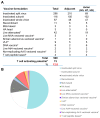Harnessing the Power of T Cells: The Promising Hope for a Universal Influenza Vaccine
- PMID: 29587436
- PMCID: PMC6027237
- DOI: 10.3390/vaccines6020018
Harnessing the Power of T Cells: The Promising Hope for a Universal Influenza Vaccine
Abstract
Next-generation vaccines that utilize T cells could potentially overcome the limitations of current influenza vaccines that rely on antibodies to provide narrow subtype-specific protection and are prone to antigenic mismatch with circulating strains. Evidence from animal models shows that T cells can provide heterosubtypic protection and are crucial for immune control of influenza virus infections. This has provided hope for the design of a universal vaccine able to prime against diverse influenza virus strains and subtypes. However, multiple hurdles exist for the realisation of a universal T cell vaccine. Overall primary concerns are: extrapolating human clinical studies, seeding durable effective T cell resident memory (Trm), population human leucocyte antigen (HLA) coverage, and the potential for T cell-mediated immune escape. Further comprehensive human clinical data is needed during natural infection to validate the protective role T cells play during infection in the absence of antibodies. Furthermore, fundamental questions still exist regarding the site, longevity and duration, quantity, and phenotype of T cells needed for optimal protection. Standardised experimental methods, and eventually simplified commercial assays, to assess peripheral influenza-specific T cell responses are needed for larger-scale clinical studies of T cells as a correlate of protection against influenza infection. The design and implementation of a T cell-inducing vaccine will require a consensus on the level of protection acceptable in the community, which may not provide sterilizing immunity but could protect the individual from severe disease, reduce the length of infection, and potentially reduce transmission in the community. Therefore, increasing the standard of care potentially offered by T cell vaccines should be considered in the context of pandemic preparedness and zoonotic infections, and in combination with improved antibody vaccine targeting methods. Current pandemic vaccine preparedness measures and ongoing clinical trials under-utilise T cell-inducing vaccines, reflecting the myriad questions that remain about how, when, where, and which T cells are needed to fight influenza virus infection. This review aims to bring together basic fundamentals of T cell biology with human clinical data, which need to be considered for the implementation of a universal vaccine against influenza that harnesses the power of T cells.
Keywords: T cell; influenza virus; universal vaccine.
Conflict of interest statement
The authors declare no conflict of interest.
Figures



Similar articles
-
A Bivalent Heterologous DNA Virus-Like-Particle Prime-Boost Vaccine Elicits Broad Protection against both Group 1 and 2 Influenza A Viruses.J Virol. 2017 Apr 13;91(9):e02052-16. doi: 10.1128/JVI.02052-16. Print 2017 May 1. J Virol. 2017. PMID: 28179535 Free PMC article.
-
Vaccination with Recombinant Parainfluenza Virus 5 Expressing Neuraminidase Protects against Homologous and Heterologous Influenza Virus Challenge.J Virol. 2017 Nov 14;91(23):e01579-17. doi: 10.1128/JVI.01579-17. Print 2017 Dec 1. J Virol. 2017. PMID: 28931689 Free PMC article.
-
Synthetic Toll-like receptor 4 (TLR4) and TLR7 ligands as influenza virus vaccine adjuvants induce rapid, sustained, and broadly protective responses.J Virol. 2015 Mar;89(6):3221-35. doi: 10.1128/JVI.03337-14. Epub 2015 Jan 7. J Virol. 2015. PMID: 25568203 Free PMC article.
-
Heterosubtypic T-Cell Immunity to Influenza in Humans: Challenges for Universal T-Cell Influenza Vaccines.Front Immunol. 2016 May 19;7:195. doi: 10.3389/fimmu.2016.00195. eCollection 2016. Front Immunol. 2016. PMID: 27242800 Free PMC article. Review.
-
Towards a universal influenza vaccine: different approaches for one goal.Virol J. 2018 Jan 19;15(1):17. doi: 10.1186/s12985-017-0918-y. Virol J. 2018. PMID: 29370862 Free PMC article. Review.
Cited by
-
Intranasal Nanoparticle Vaccination Elicits a Persistent, Polyfunctional CD4 T Cell Response in the Murine Lung Specific for a Highly Conserved Influenza Virus Antigen That Is Sufficient To Mediate Protection from Influenza Virus Challenge.J Virol. 2021 Jul 26;95(16):e0084121. doi: 10.1128/JVI.00841-21. Epub 2021 Jul 26. J Virol. 2021. PMID: 34076479 Free PMC article.
-
Enhancing the use of T cells as a universal preventive measure against H3N2 influenza: Mechanism and implications.Health Sci Rep. 2024 Aug 20;7(8):e70004. doi: 10.1002/hsr2.70004. eCollection 2024 Aug. Health Sci Rep. 2024. PMID: 39170886 Free PMC article. No abstract available.
-
R-DOTAP Cationic Lipid Nanoparticles Outperform Squalene-Based Adjuvant Systems in Elicitation of CD4 T Cells after Recombinant Influenza Hemagglutinin Vaccination.Viruses. 2023 Feb 15;15(2):538. doi: 10.3390/v15020538. Viruses. 2023. PMID: 36851752 Free PMC article.
-
Challenging immunodominance of influenza-specific CD8+ T cell responses restricted by the risk-associated HLA-A*68:01 allomorph.Nat Commun. 2019 Dec 6;10(1):5579. doi: 10.1038/s41467-019-13346-4. Nat Commun. 2019. PMID: 31811120 Free PMC article.
-
Randomized, Double-Blind, Reference-Controlled, Phase 2a Study Evaluating the Immunogenicity and Safety of OVX836, A Nucleoprotein-Based Influenza Vaccine.Front Immunol. 2022 Apr 7;13:852904. doi: 10.3389/fimmu.2022.852904. eCollection 2022. Front Immunol. 2022. PMID: 35464450 Free PMC article. Clinical Trial.
References
-
- Palache A., Abelin A., Hollingsworth R., Cracknell W., Jacobs C., Tsai T., Barbosa P., IFPMA Influenza Vaccine Supply (IFPMA IVS) task force Survey of distribution of seasonal influenza vaccine doses in 201 countries (2004–2015): The 2003 World Health Assembly resolution on seasonal influenza vaccination coverage and the 2009 influenza pandemic have had very little impact on improving influenza control and pandemic preparedness. Vaccine. 2017;35:4681–4686. - PubMed
-
- Xie H., Wan X.F., Ye Z., Plant E.P., Zhao Y., Xu Y., Li X., Finch C., Zhao N., Kawano T., et al. H3N2 Mismatch of 2014–15 Northern Hemisphere Influenza Vaccines and Head-to-head Comparison between Human and Ferret Antisera derived Antigenic Maps. Sci. Rep. 2015;5:15279. doi: 10.1038/srep15279. - DOI - PMC - PubMed
Publication types
LinkOut - more resources
Full Text Sources
Other Literature Sources
Research Materials

